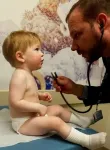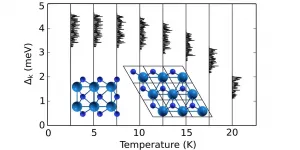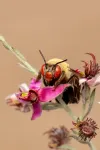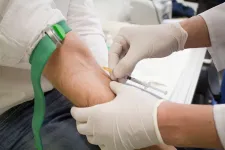(Press-News.org) Philadelphia, May 5, 2021--When Luke Terrio was about seven months old, his mother began to realize something was off. He had constant ear infections, developed red spots on his face, and was tired all the time. His development stagnated, and the antibiotics given to treat his frequent infections stopped working. His primary care doctor at Children's Hospital of Philadelphia (CHOP) ordered a series of blood tests and quickly realized something was wrong: Luke had no antibodies.
At first, the CHOP specialists treating Luke thought he might have X-linked agammaglobulinemia (XLA), a rare immunodeficiency syndrome seen in children. However, as the CHOP research team continued investigating Luke's case, they realized Luke's condition was unlike any disease described before.
Using whole exome sequencing to scan Luke's DNA, CHOP researchers discovered the genetic mutation responsible for his condition, which prevents Luke and patients like him from making B cells and antibodies to fight infections. The study describing Luke's condition, which CHOP researchers named PU.1 Mutated agammaglobulinemia (PU.MA), was published today in the Journal of Experimental Medicine.
"It can be pretty scary for a family whose child has a mysterious illness" said Neil D. Romberg, MD, an attending physician with the Division of Allergy and Immunology at CHOP and senior author of the paper. "In this case, science provided an explanation, thanks to numerous departments at CHOP, including the Roberts Individualized Medical Genetics Center, the Center for Spatial and Functional Genomics, and the Cancer Center. Understanding the cause of Luke's condition absolutely helped us know what direction to take his therapy."
"I was so impressed with how all of the specialists at CHOP worked together as a team, even though they specialized in different areas," said Luke's mother, Michelle. "They knew something was wrong with Luke, and they didn't stop digging until they figured it out."
Figuring Out the "Why"
To pinpoint the gene at fault, CHOP researchers compared whole exome sequences from 30 patients across the globe who were born without B lymphocytes, the cells which produce antibodies. From the larger group, they identified six patients, including Luke, who had a mutation in a gene called SPI1, which encodes the PU.1 protein. PU.1 helps B lymphocytes developing in bone marrow to open up "doors" in their chromatin, a type of tightly packed DNA. Without PU.1, those door remains shut, and the B cells never form. The six PU.MA patients, who ranged in age from 15 months to 37 years, each had different SPI1 mutations but shared insufficient levels of PU.1, absent B cells and, consequently, zero antibodies.
To validate the roles of SPI1 and PU.1, the researchers used CRISPR to reconstitute the condition in vitro. Using donated cord blood of patients who lacked SPI1 mutations, the researchers employed CRISPR to edit the patients' SPI1 mutations into the donated cord blood genes. After culturing the cells for six weeks and sequencing the cells that survived, they found B cells were specifically intolerant of PU.1 changes.
Treatment Without a Playbook
Because Luke's condition was entirely new, there was no playbook for his family or his medical team to follow. After consulting with the research team, the family decided to proceed with a bone marrow transplant in the hope that the procedure would help him make his own B cells and antibodies. Soon they discovered they had a perfect match living under their own roof: Luke's older brother, Jack.
At three and a half years of age, Jack, who has high-functioning autism, donated his bone marrow to Luke. The transplant was successful at getting Luke to produce his own B cells. Until those B cells are able to create enough protective antibodies by themselves, Luke continues to receive infection protection from the antibody infusions he receives every two weeks.
"We call them his ninjas," said Michelle describing antibodies. "We tell him that he doesn't make his own ninjas, so he needs these ninja infusions to fight the germs and keep him safe."
Thanks to those "ninjas" and his brother's gift of bone marrow, Luke is now an energetic 4-year-old boy who loves Transformers, fire trucks, and his balance bike. Before his bone marrow transplant and the infusions, he needed naproxen twice a day for his joint pain, required leg braces to straighten his legs, and would lie on the floor exhausted tire after 10 minutes of activity. Now, he always seems to be running, often with his dog Charlie chasing behind him.
"Knowing the source of the problem removed the boogeyman for the Terrios and allowed them to move their lives forward," Romberg said. "Figuring out Luke's case not only helped guide his therapy and gave answers to others suffering with this rare condition - in some cases for years - but also opens the door to learning more about the effects of PU.1 on a variety of more common human diseases and conditions."
INFORMATION:
Le Coz et al. "Constrained chromatin accessibility in PU.1-mutated agammaglobulinemia patients," Journal of Experimental Medicine, online May 5, 2021, DOI: 10.1084/jem.20201750
About Children's Hospital of Philadelphia: Children's Hospital of Philadelphia was founded in 1855 as the nation's first pediatric hospital. Through its long-standing commitment to providing exceptional patient care, training new generations of pediatric healthcare professionals, and pioneering major research initiatives, Children's Hospital has fostered many discoveries that have benefited children worldwide. Its pediatric research program is among the largest in the country. In addition, its unique family-centered care and public service programs have brought the 595-bed hospital recognition as a leading advocate for children and adolescents. For more information, visit http://www.chop.edu
Pesticides have been used in European agriculture for more than 70 years, so monitoring their presence, levels and their effects in European soils quality and services is needed to establish protocols for the use and the approval of new plant protection products.
In an attempt to deal with this issue, a team led by the prof. Dr. Violette Geissen from Wageningen University (Netherlands) have analysed 340 soil samples originating from three European countries to compare the contentdistribution of pesticide cocktails in soils under organic farming practices and soils under conventional practices. This study was a combined effort of 3 EC funded projects addressing soil
quality: RECARE (http://www.recare-project.eu/), iSQAPER (http://www.isqaper-project.eu) ...
T-cells play a central role in our immune system: by means of their so-called T-cell receptors (TCR) they make out dangerous invaders or cancer cells in the body and then trigger an immune reaction. On a molecular level, this recognition process is still not sufficiently understood.
Intriguing observations have now been made by an interdisciplinary Viennese team of immunologists, biochemists and biophysicists. In a joint project funded by the Vienna Science and Technology Fund and the FWF, they investigated which mechanical processes take place when an antigen is recognized: ...
Larger bumblebees are more likely to go out foraging in the low light of dawn, new research shows.
University of Exeter scientists used RFID - similar technology to contactless card payments - to monitor when bumblebees of different sizes left and returned to their nest.
The biggest bees, and some of the most experienced foragers (measured by number of trips out), were the most likely to leave in low light.
Bumblebee vision is poor in low light, so flying at dawn or dusk raises the risk of getting lost or being eaten by a predator.
However, the bees benefit from extra foraging time and fewer competitors for pollen in the early morning.
"Larger bumblebees have bigger eyes than their smaller-sized nest mates and many other bees, and can therefore see better in dim light," said lead author ...
Superconductivity in two-dimensional (2D) systems has attracted much attention in recent years, both because of its relevance to our understanding of fundamental physics and because of potential technological applications in nanoscale devices such as quantum interferometers, superconducting transistors and superconducting qubits.
The critical temperature (Tc), or the temperature under which a material acts as a superconductor, is an essential concern. For most materials, it is between absolute zero and 10 Kelvin, that is, between -273 Celsius and -263 Celsius, too cold to be of any practical use. Focus has then been on finding materials with a higher Tc.
While researchers have discovered materials ...
A curiously yellow pre-supernova star has caused astrophysicists to re-evaluate what's possible at the deaths of our Universe's most massive stars. The team describe the peculiar star and its resulting supernova in a new study published today in Monthly Notices of the Royal Astronomical Society.
At the end of their lives, cool, yellow stars are typically shrouded in hydrogen, which conceals the star's hot, blue interior. But this yellow star, located 35 million light years from Earth in the Virgo galaxy cluster, was mysteriously lacking this crucial hydrogen layer at the time of its explosion.
"We haven't seen this scenario before," said Charles Kilpatrick, postdoctoral fellow at Northwestern ...
How can a highly effective drug be transported to the precise location in the body where it is needed? In the journal Angewandte Chemie, chemists at Heinrich Heine University Düsseldorf (HHU) together with colleagues in Aachen present a solution using a molecular cage that opens through ultrasonification.
Supramolecular chemistry involves the organization of molecules into larger, higher-order structures. When suitable building blocks are chosen, these systems 'self-assemble' from their individual components.
Certain supramolecular compounds are well suited for 'host-guest chemistry'. In such cases, a host structure encloses a guest molecule and can shield, protect and transport it away from its environment. This is a specialist field of Dr. Bernd M. Schmidt and ...
The United States-Mexico border traverses through large expanses of unspoiled land in North America, including a newly discovered worldwide hotspot of bee diversity. Concentrated in 16 km2 of protected Chihuahuan Desert are more than 470 bee species, a remarkable 14% of the known United States bee fauna.
This globally unmatched concentration of bee species is reported by Dr. Robert Minckley of the University of Rochester and William Radke of the United States Fish and Wildlife Service in the open-access, peer-reviewed Journal of Hymenoptera Research.
Scientists studying native U.S. bees have long recognized that the Sonoran and Chihuahuan deserts of North America, home to species with interesting life histories, have high bee biodiversity. Exactly how many species ...
Sanaria® PfSPZ-CVac" is a live vaccine consisting of infectious Plasmodium falciparum (Pf) malaria parasites that are injected into the subject at the same time as they receive an antimalarial drug. The parasites quickly enter the liver where they develop and multiply for 6 days, and then emerge into the blood As soon as the parasites leave the liver, the drug kills them immediately. Thus, the immune system of the vaccinated subject is primed against many parasite proteins and becomes highly effective at killing malaria parasites in the liver to block infection and prevent disease.
"With this study, we have reached a new important milestone in the development of an effective malaria vaccine. With only three immunizations over four weeks, we achieved very good protection ...
Daniel Redhead, from the Max Planck Institute for Evolutionary Anthropology, and Chris von Rueden, from the University of Richmond, published a new study that describes coalition formation among men in Tsimané Amerindians living in Amazonian Bolivia, over a period of eight years. In two Tsimané communities, the authors describe the inter-personal conflicts that tend to arise between men, and the individual attributes and existing relationships that predict the coalitional support men receive in the event of conflicts.
Conflicts that arise between men concern disputes over access to forest for slash-and-burn horticulture, as well as accusations of theft, laziness, negligence, ...
In about a quarter of patients with hereditary diseases, the cause of the disease remains unclear even after extensive genetic testing. One reason is that we still do not know enough about the function of many genes. Of the 30,000 known genes, just a little more than 4,000 have been found to be associated with hereditary diseases.
At the Department of Clinical Genetics of the University of Tartu Institute of Clinical Medicine, under the leadership of Professor Katrin Õunap, patients with hereditary diseases of unclear cause have been studied in various research projects since 2016. In collaboration with the Broad Institute of MIT and Harvard, these patients have undergone extensive genome-wide sequencing analyses at the level of the exome (the sequence of all genes), ...







